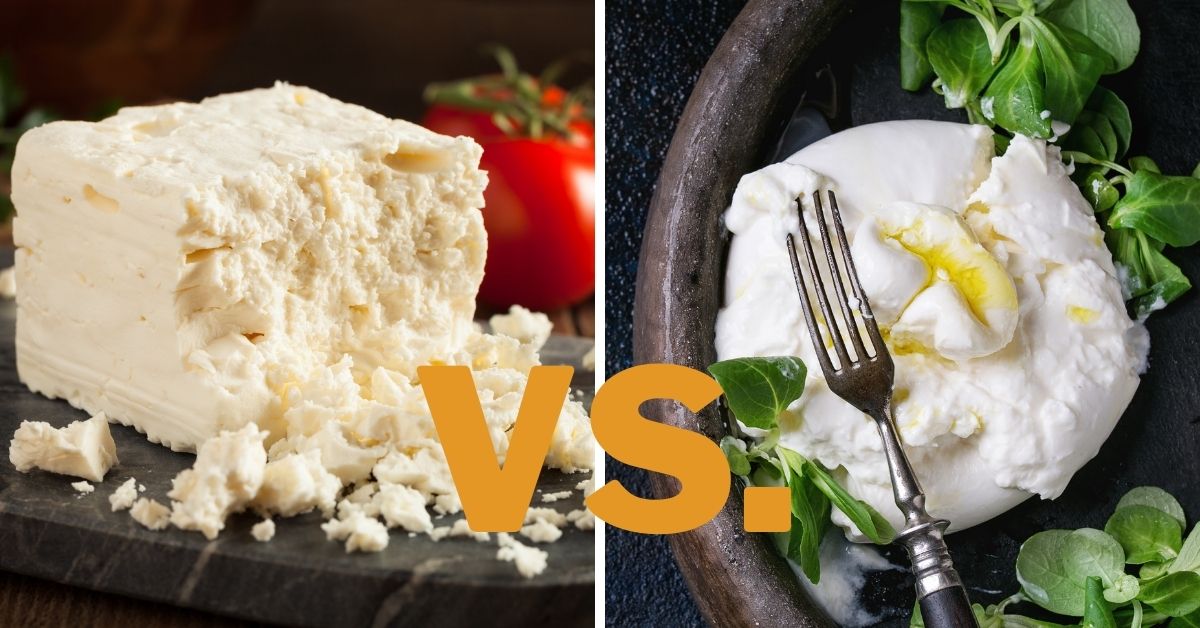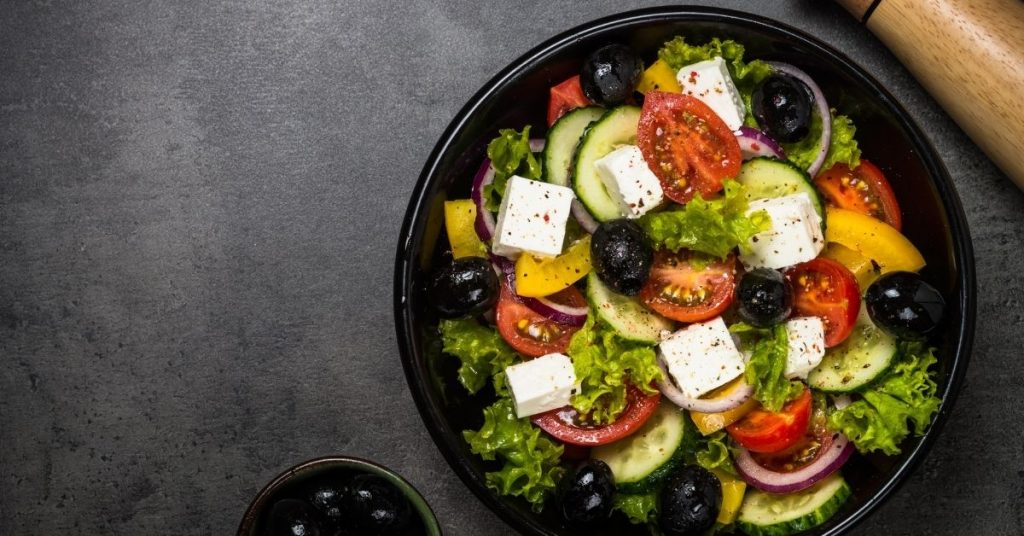Feta vs. Burrata: Differences & Which One to Use?

Both feta and burrata are supreme kinds of cheese, each seductive in its way, but at the same time different and unique. While one is elegant, hard-to-find, and carefully picks its surroundings, the other is tangy, common, and easy-to-pair. So, what are the differences, and which one is best to use: feta or burrata?
Burrata is made from cow’s or buffalo’s milk, and it mixes two kinds of cheese – solid and creamy. On the other hand, feta is a solid cheese made of sheep’s milk or a combination of sheep’s and goat’s milk. While each of them has its purposes, there are times when their uses overlap.
My personal favorite is feta, and burrata is a very close second. Depending on the mood, both of them can do an excellent job, but the mood isn’t the only factor in combining these cheeses. I will explain the differences between feta and burrata in the following paragraphs and their use.
Feta vs. Burrata: What Are the Differences?
Compared to feta, first recorded in 8BC, burrata is a relatively new cheese originating from the 1920s. Although a novelty in the cheese department, burrata has become a synonym for Italy.
Hand-woven by artisans, relying solely on taste and experience, burrata has a unique texture and structure which combines solid and creamy cheese.
Burrata is made of raw or pasteurized milk, making no difference in the production process. The milk is left to curdle, then the curds are dropped into hot whey, after which comes the weaving and pulling process. Once the strings reach the desired consistency and texture, the outer mozzarella shell is filled with cream cheese cruds, giving a soft and creamy core to the burrata block.
On the other hand, feta is a solid cheese made of either raw or pasteurized milk. The production process remains the same, regardless of the type of milk used, just like with the burrata.
In the feta production process, the milk coagulates after being poured into a large vat with rennet and casein. When the milk thickens, the artisans cut it into blocks and let them dry.
In addition to the different production processes, these two kinds of cheese differ in another aspect- aging. While feta should age for at least three months, burrata requires none, and it is at its best when served freshly made.
In terms of texture, burrata has a solid and smooth exterior and a creamy and soft interior. Once cut, the creamy core is exposed, making this cheese perfect as a dip.
Unlike burrata, feta’s texture is consistent and even. Though it is solid, feta is quite soft. It isn’t creamy, but it is perfect to dice or crumble, making it an excellent fit for salads.
Taste-wise, burrata, and feta differ largely. Burrata has a noticeable milky taste enriched with the freshness of the Mozzarella shell and cream filling. Conversely, feta is more expressive, zesty, salty, and tangy.

In terms of nutritional value, both feta and burrata are highly nutritious. Feta is low-fat and low-calorie cheese. It contains an abundance of healthy nutrients such as Vitamin B6, B12, Vitamin A, Vitamin K Sodium, Selenium, Zinc, Calcium, Riboflavin, Magnesium, and Phosphorus. [1]
Feta also contains a moderate amount of carbohydrates and proteins and is regarded as one of the healthiest cheeses. It is beneficial for the bones and improves gut health.
Burrata is a bit of a different story. As delicious as it is, you have to pace yourself with it. It is a high-calorie and high-fat cheese with high amounts of lactose and low in proteins and carbohydrates. Still, you shouldn’t underestimate its nutritional value.
Burrata has high quantities of vitamin A, Phosphorus, Sodium, vitamin D, and Calcium. [2] Moderate consumption of burrata can improve dental and bone health, but it isn’t recommended during pregnancy. It can also cause problems if you are lactose intolerant or suffer from diabetes.
| Burrata | Feta | |
|---|---|---|
| Production | Cow’s or buffalo milk left to curdle. Hand-woven strings of mozzarella filled with cream cheese. No aging is needed. | Sheep’s milk or a combination of sheep’s and goat’s milk left to coagulate. Cut into blocks. No filling. Ages for a minimum of three months. |
| Taste | Milky and fresh. | Zesty and tangy. |
| Texture | Solid and smooth exterior, but creamy core. | Solid and smooth overall. |
| Best Substitutes | Mozzarella, cottage cheese, or Cashew cheese | Cottage cheese, goat cheese |
| Nutrition | High fat and high calorie. Rich in vitamin A, Calcium, Sodium, and vitamin D. Low in protein and carbohydrates. Good for dental and bone health. | Low-fat and low-calorie. Rich in Vitamin B2 and B12, magnesium, Calcium, Zinc, Phosphorous, Vitamin A, Vitamin K, and Riboflavin. Good for bone and gut health. Considered one of the healthiest cheeses. |
Feta vs. Burrata: Which One Is Better?
It would be incorrect to say that one is better than the other, as they both have their strengths and weaknesses. The use of feta and burrata highly depends on the consumer’s taste. Still, there are some rules to follow to get the best possible experience.
Burrata is best served fresh at room temperature, but it is also a superb choice as pizza or bruschetta topping. Since it melts almost immediately, burrata, as a topping, is best used right before serving; otherwise, its taste will seriously diminish.
Burrata also works great as a side dish combined with smoked meat, fresh tomatoes or truffles, toast bread topping, or as an addition to omelets. Of course, freshly baked bread and olive oil are always its faithful companions.
Just like burrata, feta also does its magic when served fresh. Greek salad wouldn’t be Greek salad without feta. Feta also combines beautifully with roasted vegetables, crumbled in soup or anywhere you need some extra zest and saltiness.

Because it is more resilient than burrata, when it comes to melting, you can use feta as a topping during the baking process or enrich any heat-processed meals.
Because of its strong flavor, feta accentuates the features of the foods you combine it with, so pairing it with other strong flavors, could be either the best or the worst idea.
Can You Substitute Burrata for Feta?
Feta and burrata are expressively different in taste and texture, and one cannot always substitute for the other. Other than being served fresh, burrata can hardly replace feta and vice-versa. Still, burrata can do nicely in fresh salads or as a topping instead of feta.
Which Cheese Is Closest to Burrata?
Since it is already contained in the burrata shell, the best substitute for burrata is mozzarella. We will miss the creaminess, but the mozzarella freshness will be there. Also, mozzarella is a bit milder tasting and far more elastic than burrata.
Some other substitutes for burrata can also be cottage cheese or Cashew cheese due to their creaminess and milky taste.
Still, since food is an art best left to the artist, depending on your taste and creativity, you can certainly try to experiment with the use of these two kinds of cheese.
